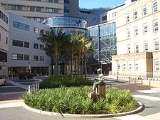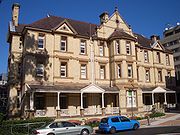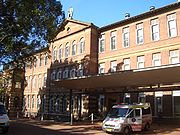
Royal Prince Alfred Hospital
Encyclopedia



Teaching hospital
A teaching hospital is a hospital that provides clinical education and training to future and current doctors, nurses, and other health professionals, in addition to delivering medical care to patients...
in Sydney, Australia
Australia
Australia , officially the Commonwealth of Australia, is a country in the Southern Hemisphere comprising the mainland of the Australian continent, the island of Tasmania, and numerous smaller islands in the Indian and Pacific Oceans. It is the world's sixth-largest country by total area...
, located on Missenden Road in Camperdown
Camperdown, New South Wales
Camperdown is an inner-city suburb of Sydney, in the state of New South Wales, Australia. Camperdown is located 4 kilometres south-west of the Sydney central business district and is part of the Inner West region...
. It is a teaching hospital of the Central Clinical School of Sydney Medical School at the University of Sydney
University of Sydney
The University of Sydney is a public university located in Sydney, New South Wales. The main campus spreads across the suburbs of Camperdown and Darlington on the southwestern outskirts of the Sydney CBD. Founded in 1850, it is the oldest university in Australia and Oceania...
and is situated in proximity to the Blackburn Building of the university's main campus. RPAH is the largest hospital in the Sydney Local Health District, with approximately 700 beds (circa 2005). Following a $350 million redevelopment, the perinatal hospital King George V Memorial Hospital
King George V Memorial Hospital
King George V Memorial Hospital was a former hospital exclusively for mothers located near the Royal Prince Alfred Hospital in Sydney, which closed down on November 14, 2002. King George V hospital was opened in 1941...
has been incorporated into it.
An Australian television documentary, RPA
RPA (TV series)
RPA is an Australian reality television show that is filmed at Royal Prince Alfred Hospital and shows the everyday workings of this major hospital in Sydney, Australia...
, is filmed there and depicts the everyday workings of a major metropolitan hospital.
History
Royal Prince Alfred is one of the oldest hospitals in NSW. The funds were raised by public subscription. This was in an effort to make a monument to commemorate the assassination attempt on Prince Alfred, Duke of EdinburghAlfred, Duke of Saxe-Coburg and Gotha
Alfred, Duke of Saxe-Coburg and Gotha was the third Duke of Saxe-Coburg and Gotha, and reigned from 1893 to 1900. He was also a member of the British Royal Family, the second son and fourth child of Queen Victoria and Prince Albert of Saxe-Coburg and Gotha...
by Henry James O'Farrell
Henry James O'Farrell
Henry James O'Farrell is infamously recorded as the first person to attempt a political assassination in Australia. In 1868, he shot and wounded HRH The Prince Alfred, Duke of Edinburgh the second son and fourth child of Queen Victoria.-Biography:...
.
Teaching
It was only two years after its establishment in 1882 that the hospital accepted its first medical students from the Medical School of the University of Sydney. Since then, the hospital has benefited from this close relationship at the teaching, research and clinical levels. For example, it is the only public hospital in Australia to offer a comprehensive revision course for the RACP written exam for basic physician trainees.Clinical services
RPA's staff of over 4,000 provides the largest number of in-patient treatments in the state, almost 500,000 out-patient treatments, 45,000 adult and paediatric emergency department patients and delivers 4,000 babies each year. With around 50 percent of all admissions being district services, RPA treats more public patients than any other hospital in the state.Within RPA itself, four clinical sections provide specialty clinical services: Division of Medicine, Division of Surgery, Division of Obstetrics & Gynaecology and Division of Diagnostic Service. In addition, a range of Allied Health services are also provided, including clinical psychology, psychiatry, health promotion, nutrition and dietetics, orthotics, occupational therapy, physiotherapy, podiatry, speech pathology, social work and volunteer service.
New facilities
RPA has undertaken an extensive program of refurbishment and construction.Public spaces including gardens for patients have been renovated; views of the city, hospital gardens and the University of Sydney. New facilities include the Hot floor, a purpose-built nucleus of critical care services designed to improve patient care and clinical outcomes. It brings together operating theatres; intensive care; high dependency units; cardiac intensive care; neuro intensive care; day-stay centre and neonatal intensive care.
Sydney Cancer Centre - The only ambulatory care centre of its type in Australia, combining diagnostic, consultative and follow-up services.
Obstetric and gynaecological services - A birthing unit with nine delivery rooms, three home-like birthing rooms and 32 neonatal cots.
Diagnostic services - Facilities include positron emission tomography; X-ray/digital scanner rooms; computerised axial tomography scanners; ultrasound room; magnetic resonance imaging (MRI); and angiography rooms.
Institute of Rheumatology and Orthopaedics - 60 bed unit covering diagnosis; surgery; medical treatment unit; rehabilitation; allied health services and hydrotherapy pool.
Day-surgery centre - 38 bed centre containing separate admissions station, operating theatres and recovery area in a calming environment.
Sydney South West Pathology Service - Eastern Zone - Laboratory services in diganostic pathology including the NSW porphyrin
Porphyrin
Porphyrins are a group of organic compounds, many naturally occurring. One of the best-known porphyrins is heme, the pigment in red blood cells; heme is a cofactor of the protein hemoglobin. Porphyrins are heterocyclic macrocycles composed of four modified pyrrole subunits interconnected at...
reference unit. Previously known as the Central Sydney Laboratory Service.
Research
The RPA campus is also home to the largest volume of medical research undertaken within NSW.Throughout its history, clinicians at the Royal Prince Alfred Hospital have been responsible for many innovations in clinical care, diagnosis and treatment, not only within Australia, but also at an international level. This is reflected in the regular publication of original articles and editorial comments by hospital staff in such medical journals as The Lancet and The New England Journal of Medicine. This reputation for excellence means it has the highest percentage of surgical admissions amongst NSW principal referral hospitals.
RPA is home to more research institutes and specialist units than any other public hospital in Australia, including:
- Melanoma Unit - the largest in the world
- National Liver Transplant Unit
- Haemophilia Centre - Australia's first major centre in this area
- Sleep Disorders Unit - an Australian first, the unit developed the revolutionary CPAP machine for sleep apnoea sufferers, and pioneered non-invasive ventilation treatment for respiratory failure.
- Sydney Cancer Centre - Australia's largest and most comprehensive cancer treatment centre
- Positron Emission Tomography Camera
- Heart Research Institute
- National Medical Cyclotron
- National Poisons Register
- Sydney Breast Cancer Institute - pioneered breast-sparing surgery in NSW
- Woolcock Institute of Medical Research - Australia's only centre devoted to respiratory and sleep diseases and the leading partner in the national Cooperative Research Centre for asthma.
- RPA Diabetes Centre - a pioneering unit which has developed into the most comprehensive centre for the multidisciplinary clinical care and research for diabetes in Australia. This was recognised by way of the Kellion Award in 2010.
- Bone Banking - In 1984 RPA orthopaedic surgeons Dr. Harry Tyer and Dr. Paul Stalley pioneered Australia's first Bone Bank using living donors undergoing elective orthopaedic procedures.
The hospital also sponsors a number of institutes at the University of Sydney, including the Heart Research Institute; Centenary Institute for Cancer Medicine and Cell Biology; Kanematsu Laboratories and General Endocrinology Group.
Royal Prince Alfred Hospital School
The Department of Education and Training operates a school within the hospital, known as Royal Prince Alfred Hospital School. Executive, teaching and administrative staffing and funding is provided by the DET in liaison with the hospital's paediatric and nursing units, and may vary according to the changing needs of the school. The school is operated as part of the Botany Bay Network of schools within the Sydney Region.RPA Hospital School provides for the educational needs of school-age children and teenagers while they are short term or long term patients at the hospital. Students undertake exams, just as they would at their home schools, including the NAPLAN
NAPLAN
NAPLAN, or National Assessment Program – Literacy and Numeracy, is a battery of tests administered to Australian students. These standardized tests assess students' reading, writing, language , and numeracy, and are administered by the Australian Curriculum, Assessment and Reporting...
, the School Certificate
School Certificate
The School Certificate was a qualification issued by the Board of Studies, New South Wales, typically at the end of Year 10. The successful completion of the School Certificate is a requirement for completion of the Higher School Certificate...
and the Higher School Certificate
Higher School Certificate
The Higher School Certificate, or HSC, is the credential awarded to secondary school students who successfully complete senior high school level studies in New South Wales, Australia. It was first introduced in 1967, with the last major revision coming into effect in 2001. It is currently...
. Where necessary, the Home-School Liaison Officer continues to work with students on return to their home schools to ensure a smooth transition, and, where necessary, the programming of individualised learning tasks to ease students back into school.

